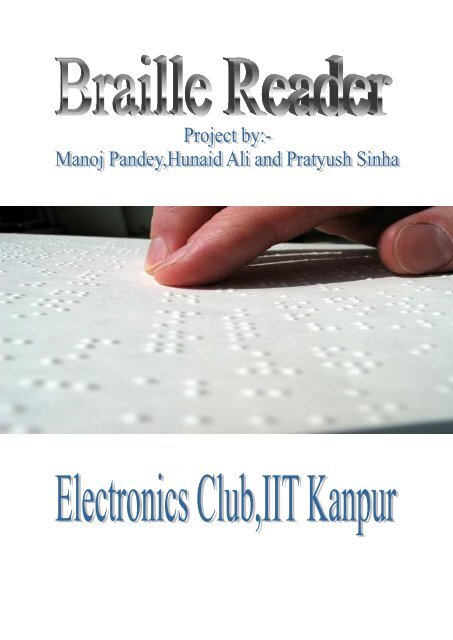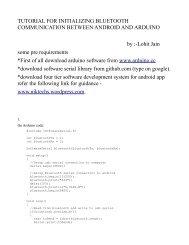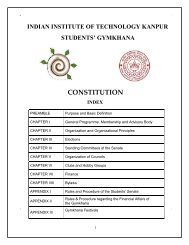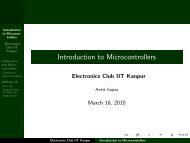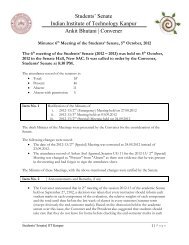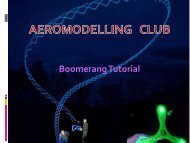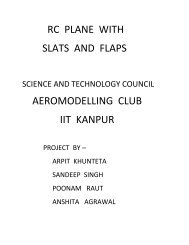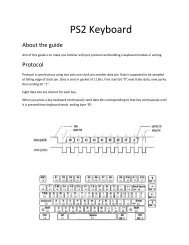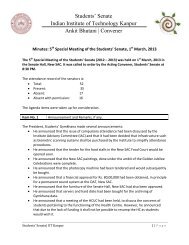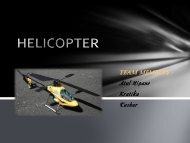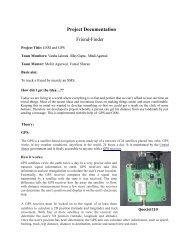The Braille Reader-Documentation
The Braille Reader-Documentation
The Braille Reader-Documentation
You also want an ePaper? Increase the reach of your titles
YUMPU automatically turns print PDFs into web optimized ePapers that Google loves.
Abstract<br />
• <strong>The</strong> project aims to make a portable equipment which can<br />
be used by a (blind & dumb)/(blind, deaf and dumb)<br />
person to communicate with other people. Something that<br />
can be used in the daily life of a person who cannot see,<br />
speak or hear”. So we ended up with this idea of a braille<br />
reader.<br />
Introduction to braille<br />
Louis Braillle(1809-1852)<br />
• <strong>The</strong> <strong>Braille</strong> system is a method that is widely used by blind<br />
people to read and write. <strong>Braille</strong> was devised in 1821 by<br />
Louis <strong>Braille</strong>, a blind Frenchman.<br />
• Statistically, history has proven that <strong>Braille</strong> reading<br />
proficiency provides an essential skill set that allows<br />
visually impaired people to compete with their sighted<br />
peers.<br />
• Each <strong>Braille</strong> character or cell is made up of six dot<br />
positions, arranged in a rectangle containing two columns<br />
of three dots each.<br />
• Using the possible combinations of the six dots any<br />
character(alphabets(lower or upper case),numbers,special<br />
characters) can be generated.
Project Design<br />
IDEAS:-<br />
We had planned our device to be a portable one.<br />
However, to communicate this signal to the blind person<br />
we could only use the sense of touch. For this problem we<br />
had considered the following ideas :<br />
1.Using slots with buttons that would move up and down<br />
using a motor. We rejected this idea too as it would make<br />
the device difficult to carry.<br />
2.Using coin vibrators. This seemed to be a technically<br />
feasible idea but we were unable to obtain the vibrators.<br />
3.So we finally settled on using mobile phone vibrators.<br />
<strong>The</strong> blind person would now receive the signal using a<br />
3×2 matrix of mobile phone vibrators.<br />
<strong>The</strong> hardware part of project design consists of Atmega<br />
16(microcontroller),16x2 LCD screen,PS2 keyboard,push<br />
buttons,mobile vibrators,resistors(all embedded on a<br />
development board).<br />
<strong>The</strong> six pins of PORT A of Atmega 16 has been<br />
connected to the six push buttons which act like the six<br />
dots of braille.<strong>The</strong> blind person can push the any<br />
combination of six buttons to display a character on LCD.
Capital letter follows.<br />
Number follows.<br />
Above are the examples of some the characters of braille<br />
script.<br />
<strong>The</strong> LCD has been connected to the pins of PORT B of<br />
Atmega 16.<br />
For the normal person to communicate with the blind,he<br />
can use the PS2 keyboard which has been interafced with<br />
the Atmega to display characters on LCD.<br />
KEYBOARD INTERFACING WITH ATMEGA16
<strong>The</strong> keyboard interfacing was one of the important part of<br />
the project.<strong>The</strong> four wires coming out of the keyboard cord<br />
was connected to the four pins of Atmega 16.<strong>The</strong> four pins<br />
are Vcc,Ground,Interrupt and data pin.<br />
When a key is pressed,keyboard sends a clock pulse as<br />
well as a data pulse.It takes data at every falling edge of<br />
the clock pulse.<br />
<strong>The</strong> data pulse consists of 11 bits.First,a start bit followed<br />
by eight data bits,followed by a parity bit and finally a stop<br />
bit.<br />
PORTD.2 has been used as the interrupt pin connected to<br />
the wire which sends out clock pulse from the keyboard.<br />
PORTD.3 has been as the data pin connected to the wire<br />
which sends out data pulse from the keyboard.<br />
<strong>The</strong> PS2 protocol written in c code (which is a simple<br />
RS232 protocol) makes the interfacing possible.<br />
<strong>The</strong> input given from the keyboard is displayed on the<br />
LCD.At the same time,the mobile vibrators arranged in a<br />
2x3 matrix vibrates.For example:-for character ’a’ first<br />
vibrator vibrates,for character ‘b’ first two vibrator<br />
vibrates.<strong>The</strong> blind person can feel the vibrators to identify<br />
the characters.<br />
<strong>The</strong> software application includes CVAvr which has been<br />
used to write and compile the C code of the project.<strong>The</strong><br />
microcontroller has been programmed using STK500<br />
programmer in AVR Studio.<strong>The</strong> C code includes the<br />
functions to display the characters of all possible<br />
combinations of six dots using lcd_putchar() command.It
also include the PS2 protocol to dispaly characters on<br />
LCD.<br />
APPlication of the project<br />
<strong>The</strong>re are many braille writers available in the market. But this<br />
project is not like those braille writers.<br />
This product is unique in the sense that it allows the 2-way<br />
communication between a blind person and a normal person<br />
without the use of any audio or video signals.This product can<br />
be actually brought out in the market and can be used by the<br />
blind person.<br />
Conclusion<br />
<strong>The</strong> project can be said to be a success.But still there are many<br />
features which can be added to this project to enhance the<br />
applicability of the product we are trying to make.<br />
Scope of improvement:-<br />
• Using mobile keypad instead of keyboard.<br />
• Try to store the data so that can be viewed later.<br />
• Connecting the MCU to the computer using UART
Pictures Related To <strong>The</strong> project:-
Acknowledgement<br />
We would like to express our gratitude to the coordinators of<br />
electronics club for their unconditional support and guidance.<br />
We also thank our mentor Abhinav Prateek, and for his<br />
constant support without whose help this project would not<br />
have been a success.<br />
REFRENCE:-<br />
en.wikipedia.org/wiki/<strong>Braille</strong><br />
www.omniglot.com/writing/braille.htm


